“Wherever I go in America, I like it when the land speaks its own language in its own regional accent.”
— Lady Bird Johnson, Wildflowers Across America (1993)
Perfectly adapted to Central Florida’s often overwhelming conditions, native plants can withstand the barrage of drought, steady Florida sun, and more humid conditions than plants from other areas. They also encourage pride in regional landscapes, truly showcasing the natural state of our area and the unique flora available here. Plus, Florida-native plants have the added benefit of needing the least amount of care, since they belong here already, and are a lot more forgiving on the local ecosystem.
There are plenty of Florida-Native plants available for you to build your own perfect landscape or garden, but we’ve put together our favorite Florida Plants that will outlast heat, drought, and humidity, while making your garden or landscaping the envy of the neighborhood.

1. Firebush
As its name suggests, Firebush is a garden shrub with clusters of flashy, bright orange flowers. Attracting both birds and butterflies, this perennial plant is hardy and practically bullet-proof once it has settled in. Gardeners will be able to enjoy flowers from late spring until the first frost, as these plants will produce flowers throughout the warmer seasons. If you’re looking for something to attract in pollinators like hummingbirds, bees, and butterflies, the Firebush is a must-have! Heat and drought tolerant, this root-hardy perennial is perfect for hedges, mixed borders, or a stand-alone shrub.
A Firebush can be planted in late spring or summer in USDA Zones 8 – 11. They prefer full-sun, but can also thrive in partial shade. Well-drained soil will work best for this plant, and does well if watered regularly until it is fully established. Plus, Firebush loves limestone soil, which we have in abundance here in Central Florida! Depending on growing factors, Firebush can grow as large as 15 feet tall in areas it grows all-year round, but can be easily kept at 5 or 8 feet if pruned correctly– but, keep in mind that over pruning can reduce blooming! There is no serious insect or disease problems associated with this plant.
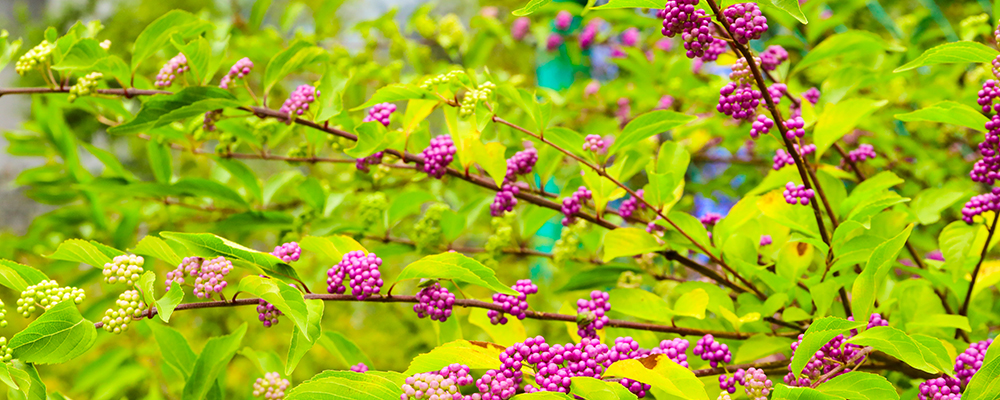
2. Beautyberry
A physically impressive plant, Beautyberry is a stunning plant that will attract plenty of birds to the area. Beautyberry, also known as the American Mulberry, will bloom with pale lavender-pink flowers along the branches from spring to summer, which then mature into vibrant purple, jewel-like fruits by September. The showy cluster of purple fruits are densely packed and encircle the woody stems of the plant, and will likely be devoured by birds. If not, the fruits will persist for several weeks after the plant drops its leaves.
Beautyberries can be planted at any time of the year, and will be drought-tolerant once established. Watering regularly until it has established will ensure the longevity of the plant. It prefers richer soils, but can also grow in poor, sandy soils as well. A small, sprawling shrub, the Beautyberry works will in borders or as a specimen plant. Regularly reaching anywhere from 3 – 8 feet tall, and 4 – 8 feet wide, pruning will keep the plant a bit more compact– but, be sure to prune the plant before it flowers! American Beautyberry can be cultivated in USDA Zones 7 – 11.
There are several varieties that can thrive here in Florida: C. Americana, which is the Beautyberry featured here, Callicarpa Japonica, a non-native plant with a more compact stature (4 – 6 feet tall and wide), C. Dichomata, a compact Asian species that reaches 3 – 5 feet and features white fruits called ‘Albifructus’ or ‘Albescens.’
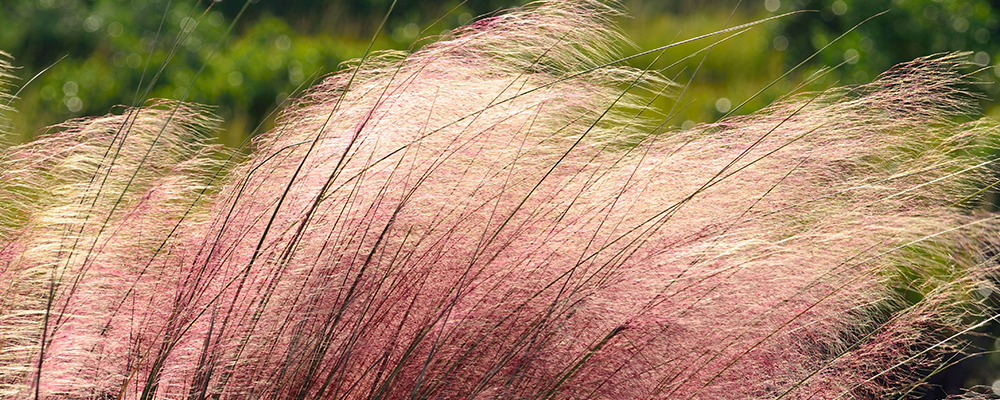
3. Muhly Grass
Got some space in your garden or lawn that needs to be filled? Muhly Grass should be your go-to! This easily grown ornamental grass produces fluffy pink, purple, and white flower stalks that can reach up to 2 – 3 feet tall and 3 feet wide when mature. This feathery texture gives its surrounds a dreamy, fairy-like look, especially in the summer breeze. Planting Muhly Grass in large groups creates a stunning visual effect, especially when the flowers are back-lit in the late afternoon. Even after the stalks fade, this grass looks great in the garden thanks to its classic slender, dark green foliage.
Found throughout Florida, Muhly Grass is often used in borders or in mass plantings. Ideally, these plants should be space 24 – 36 inches apart for best growth. Muhly Grass does best in a sunny area, and new plants will need extra water until they’ve established root systems– afterwards, they have amazing drought tolerance and can be trusted to do their thing. Cut back to the ground in later winter before the spring flush of foliage appears for best yearly growth. You can also fertilize them at this point, as they will begin rapidly growing again in spring. Looking to fill more areas? As they age, mature plants can be lifted in early spring and divided to create new plants! Muhly Grass can be cultivated in USDA Zones 7 – 11.
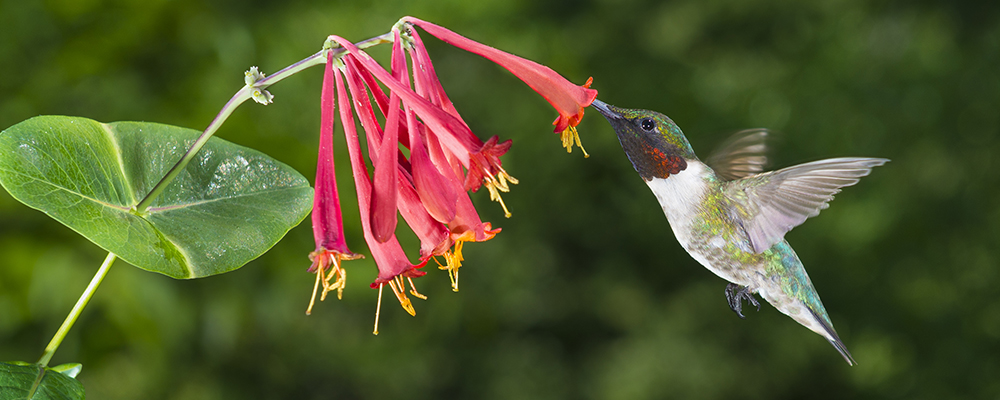
4. Coral Honeysuckle
This flowering vine, with vibrant red, trumpet-shaped blooms, is a must-have for fences, trellises, or arbors! Coral Honeysuckle, also known as Trumpet Honeysuckle, produces bright red tubular flowers throughout spring and summer. Some variations may also produce yellow flowers! Pollinators such as hummingbirds, bees, and butterflies will flock to this plant in full bloom, and songbirds will be drawn to the honeysuckle as the flowers mature into berries in late summer and fall. The leaves will stay evergreen throughout the cooler months, so even when it is out of bloom, this plant is a well-rounded addition to landscaping.
Much tougher than it looks, Coral Honeysuckle does best in slightly acidic soil and full sun. However, this plant can also tolerate most soil types and conditions, including partial shade. These plants can be cultivated in USDA Zones 4 – 10A. Generally low-maintenance once established, Coral Honeysuckle is drought tolerant and does not attract pests. This pretty plant may require the occasional pruning, as individual stems may grow as large as 15 feet in length. As a bonus to you, the Coral Honeysuckle blooms will produce a lovely floral scent that you can enjoy for weeks!
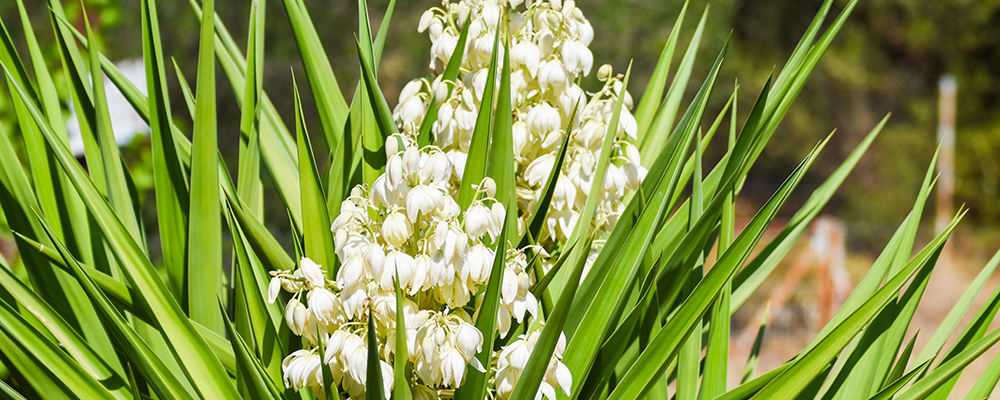
5. Yucca
A visually striking and especially tough plant, the Yucca is a welcome addition to almost any landscape. Stiff, dagger-like leaves come in a variety of vibrant green shades, and they produce bright white blossoms at the center of the plant. The Yucca makes a great focal point or specimen plant, with a dramatic flare and interesting color scheme.
Yucca can take almost anything Central Florida’s weather will throw at it, from extreme heat to drought to humidity. Spanish Bayonet, Mound Lily Yucca, and Adam’s Needle are Florida-Natives, and can be found in most nurseries in the area. They come in a variety of sizes and have sharply pointed leaves, so be sure to plant them in the right place! Flowers should begin to blossom in springtime to late summer, depending on the year. Even more interesting is their high tolerance to salt, making them ideal for seaside planting as well! Most varieties can be easily grown in USDA Zones 7B – 10, though some varieties may be able to be grown in as low of a zone as 6.
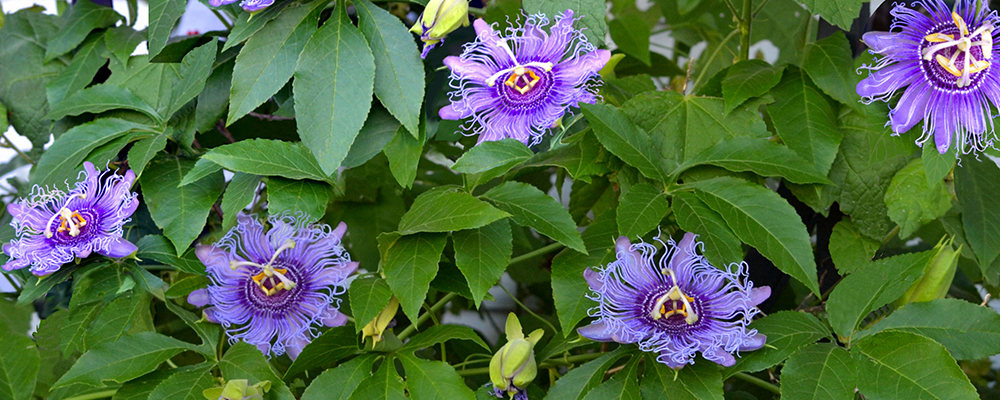
6. Passion Flower
If you’re looking for a unique, eye-catching addition to your landscaping, take a look at the Passion Flower! Deceptively delicate, the Passion Flower can tolerate even the driest and most punishing of Central Florida summers. Perfect for a trellis or fence, this perennial flowering vine produces large, deep indigo flowers with five petals covered by curly fringe. The blooms come in shades of lavender or purple, and can be 3 – 5 inches. Each flower lasts about a day during the summer and early fall, before maturing into a green fruit (which are edible, but reportedly not very tasty.) The leaves are evergreen, allowing for a nice accent plant throughout the year, regardless of blooms.
The Passion Flower will often spread beyond its original planting spot, so giving this vine room to roam is ideal. It can tolerate VERY dry conditions, and can be grown in a variety of soil types. Full-sun is best for flowering and growth, but may do okay in a partial shaded area as long as the majority of the day is in the sun. These plants can be cultivated in USDA Zones 7B – 11, and will typically grow very quickly. For those looking to attract butterflies, Passion Flowers are a host plant for the Gulf Fritillary Butterfly, and a must-have for butterfly gardens.
If you’re not loving everything on this list, we advise you to take a look at this comprehensive list provided by the UF/IFAS Extension to help you decide on the best plants for your next project. Their mission is to develop knowledge in agricultural, human, and natural resources, and they have amazing resources available for you to use. You can also feel free to contact us, we’ll be happy to share with you what we’ve learned from our many seasons planting and growing in Central Florida!